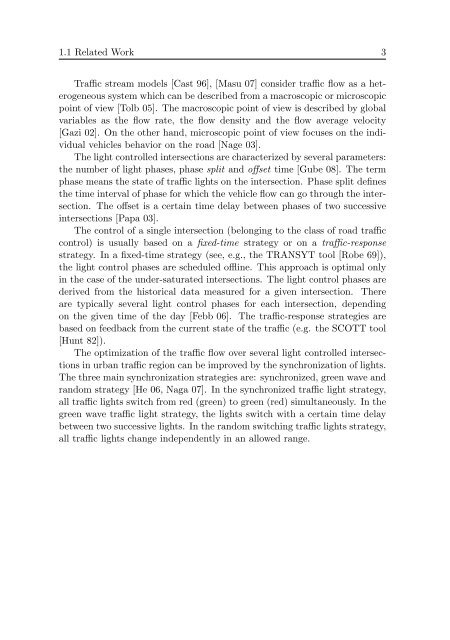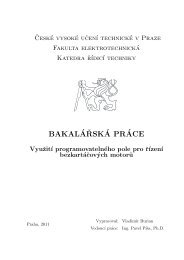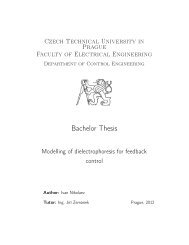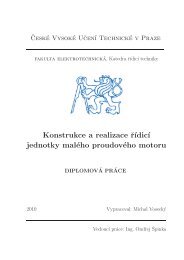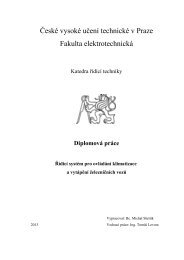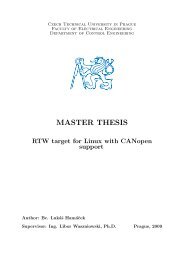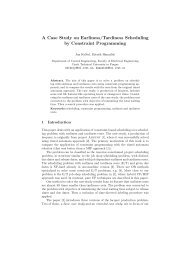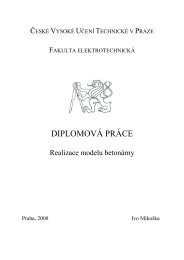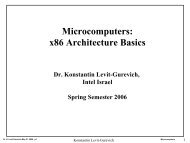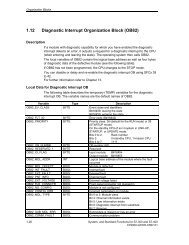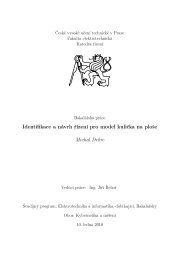Modeling and Optimization of Traffic Flow in Urban Areas - Czech ...
Modeling and Optimization of Traffic Flow in Urban Areas - Czech ...
Modeling and Optimization of Traffic Flow in Urban Areas - Czech ...
You also want an ePaper? Increase the reach of your titles
YUMPU automatically turns print PDFs into web optimized ePapers that Google loves.
1.1 Related Work 3<strong>Traffic</strong> stream models [Cast 96], [Masu 07] consider traffic flow as a heterogeneoussystem which can be described from a macroscopic or microscopicpo<strong>in</strong>t <strong>of</strong> view [Tolb 05]. The macroscopic po<strong>in</strong>t <strong>of</strong> view is described by globalvariables as the flow rate, the flow density <strong>and</strong> the flow average velocity[Gazi 02]. On the other h<strong>and</strong>, microscopic po<strong>in</strong>t <strong>of</strong> view focuses on the <strong>in</strong>dividualvehicles behavior on the road [Nage 03].The light controlled <strong>in</strong>tersections are characterized by several parameters:the number <strong>of</strong> light phases, phase split <strong>and</strong> <strong>of</strong>fset time [Gube 08]. The termphase means the state <strong>of</strong> traffic lights on the <strong>in</strong>tersection. Phase split def<strong>in</strong>esthe time <strong>in</strong>terval <strong>of</strong> phase for which the vehicle flow can go through the <strong>in</strong>tersection.The <strong>of</strong>fset is a certa<strong>in</strong> time delay between phases <strong>of</strong> two successive<strong>in</strong>tersections [Papa 03].The control <strong>of</strong> a s<strong>in</strong>gle <strong>in</strong>tersection (belong<strong>in</strong>g to the class <strong>of</strong> road trafficcontrol) is usually based on a fixed-time strategy or on a traffic-responsestrategy. In a fixed-time strategy (see, e.g., the TRANSYT tool [Robe 69]),the light control phases are scheduled <strong>of</strong>fl<strong>in</strong>e. This approach is optimal only<strong>in</strong> the case <strong>of</strong> the under-saturated <strong>in</strong>tersections. The light control phases arederived from the historical data measured for a given <strong>in</strong>tersection. Thereare typically several light control phases for each <strong>in</strong>tersection, depend<strong>in</strong>gon the given time <strong>of</strong> the day [Febb 06]. The traffic-response strategies arebased on feedback from the current state <strong>of</strong> the traffic (e.g. the SCOTT tool[Hunt 82]).The optimization <strong>of</strong> the traffic flow over several light controlled <strong>in</strong>tersections<strong>in</strong> urban traffic region can be improved by the synchronization <strong>of</strong> lights.The three ma<strong>in</strong> synchronization strategies are: synchronized, green wave <strong>and</strong>r<strong>and</strong>om strategy [He 06, Naga 07]. In the synchronized traffic light strategy,all traffic lights switch from red (green) to green (red) simultaneously. In thegreen wave traffic light strategy, the lights switch with a certa<strong>in</strong> time delaybetween two successive lights. In the r<strong>and</strong>om switch<strong>in</strong>g traffic lights strategy,all traffic lights change <strong>in</strong>dependently <strong>in</strong> an allowed range.


